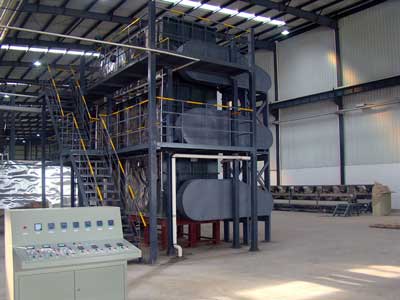The sludge dryer is a product upgraded and upgraded by our factory on the basis of the original blade dryer. The equipment has high thermal efficiency; the sludge dryer can indirectly heat or cool the paste, granular, powder and slurry materials. Unit operations such as drying, cooling, heating, sterilization, reaction, and low temperature combustion. The special wedge-type stirring heat transfer blade in the equipment has high heat transfer efficiency and self-cleaning function of the heat transfer surface.
Sludge dryer working principle
A hollow hollow blade is densely arranged on the hollow shaft, and the heat medium flows through the blade through the hollow shaft. The heat transfer area in the effective volume per unit is large, and the temperature of the heat medium is from -40 ° C to 320 ° C. It can be water vapor or liquid type: such as hot water and heat transfer oil. Indirect conduction heating, no air is carried away to remove heat, and heat is used to heat the material. The heat loss is only the heat dissipation to the environment through the insulation of the body. The wedge-shaped blade heat transfer surface has a self-cleaning function. The relative movement of the material particles and the wedge surface produces a scrubbing action, which can wash away the adhering material on the wedge surface, so that a clean heat transfer surface is maintained during operation. The shell of the paddle dryer is of the omega type, and two to four hollow agitating shafts are generally arranged in the casing. The housing has a sealed end cover and an upper cover to prevent material dust from leaking out and fully functioning.
The heat transfer medium passes through the rotary joint and flows through the casing jacket and the hollow agitating shaft. The hollow agitating shaft has different internal structures according to the type of the heat medium to ensure a good heat transfer effect.
Performance characteristics
(1) Low energy consumption of sludge dryer: Due to indirect heating, there is not a large amount of air carrying heat, and the outer wall of the dryer is provided with an insulation layer. For the slurry material, only 1.2 kg of water vapor is required to evaporate 1 kg of water.
(2) Low cost of the blade dryer system: The huge heat transfer surface in the effective volume of the unit shortens the processing time and the size of the device becomes smaller. It greatly reduces the building area and building space.
(3) Wide range of processing materials: Different heat media can be used to process both heat sensitive materials and materials requiring high temperature treatment. Commonly used media are: water vapor, heat transfer oil, hot water, cooling water, etc. It can be operated continuously or intermittently and can be applied in many fields.
(4) Small environmental pollution: No air is carried in, and dust materials are rarely entrained. The solvent evaporation of the material is small and easy to handle. For contaminated materials or conditions requiring recovery of solvents,Closed loop.
(5) Low operating cost: structure. The amount of wear is small and the maintenance cost is low.
(6) Stable operation: Due to the special compression-expansion stirring effect of the wedge-shaped blade, the material particles are fully in contact with the heat transfer surface, and the temperature, humidity and mixing gradient of the material are small in the axial interval, thereby ensuring The stability of the process.
Adaptable material
The paddle dryer has been successfully used in food, chemical, petrochemical, dye, industrial sludge and other fields. The heat transfer, cooling, and agitation characteristics of the equipment enable it to perform the following unit operations: combustion (low temperature), cooling, drying (solvent recovery) heating (melting), reaction, and sterilization. The agitating paddle is also a heat transfer surface, which increases the heat transfer area per unit effective volume and shortens the processing time.
The wedge-shaped blade heat transfer surface has a self-cleaning function. Compression – the expansion and agitation function makes the material mix evenly. The material moves in a “plug flow” along the axial direction, and the temperature, humidity, and mixing gradient of the material are small in the axial interval. Low temperature combustion can be accomplished by using a heat transfer oil as a hot medium paddle dryer. For example, calcium sulfate dihydrate (Ca2SO4•2H2O) is converted into calcium sulfate hemihydrate (Ca2SO4•1/22H2O). Sodium hydrogencarbonate (NaHCO3) is calcined to be converted into soda ash (Na2HCO3) or the like.
Cooling medium such as water, cooled brine, etc. can be used for cooling. For example, the paddle type alkali machine used in the soda ash industry replaces the old air-cooled alkali machine, which saves energy and exhaust gas treatment equipment and reduces operating costs. Dry, the main function of the equipment, without the use of hot air, so that solvent recovery, energy consumption, environmental control is in an ideal state of easy handling. It is especially suitable for the need to recover solvents, flammable and easy to oxidize heat sensitive materials. Has been widely used in fine chemicals, petrochemicals, dyes industry. The uniformity of temperature, humidity, and mixing in the axial section allows the equipment to be used to heat or melt, or to react with some solid materials. It has been successfully used in the compound fertilizer and modified starch industries. A paddle dryer can be used to sterilize food and flour. The large heating area in the effective volume of the unit quickly heats the material to the sterilization temperature, avoiding prolonged heating and changing the quality of the material.
Technical specifications
| Project model | JYG3 | JYG9 | JYG13 | JYG18 | JYG29 | JYG41 | JYG52 | JYG68 | JYG81 | JYG95 | YJG110 |
| Heat transfer area(m2) | 3 | 9 | 13 | 18 | 29 | 41 | 52 | 68 | 81 | 95 | 110 |
| Effective volume(m3) | 0.06 | 0.32 | 0.59 | 0.59 | 1.85 | 2.8 | 3.96 | 5.21 | 6.43 | 8.07 | 9.46 |
| range of rotation(rmp) | 15-30 | 10-25 | 10-25 | 10-20 | 10-20 | 10-20 | 10-20 | 10-20 | 5-15 | 5-15 | 5-10 |
| power(kw) | 2.2 | 4 | 5.5 | 7.5 | 11 | 15 | 30 | 45 | 55 | 75 | 95 |
| Body widthA(mm) | 306 | 584 | 762 | 940 | 1118 | 1296 | 1476 | 1652 | 1828 | 2032 | 2210 |
| Total width B(mm) | 736 | 841 | 1066 | 1320 | 1474 | 1676 | 1854 | 2134 | 1186 | 2438 | 2668 |
| Body width C(mm) | 1956 | 2820 | 3048 | 3328 | 4114 | 4724 | 5258 | 5842 | 6020 | 6124 | 6122 |
| Total length D(mm) | 2972 | 4876 | 5486 | 5918 | 6808 | 7570 | 8306 | 9296 | 9678 | 9704 | 9880 |
| In and out materialE(mm) | 1752 | 2540 | 2768 | 3048 | 3810 | 4420 | 4954 | 5384 | 5562 | 5664 | 5664 |
| Center height F(mm) | 380 | 380 | 534 | 610 | 762 | 915 | 1066 | 1220 | 1220 | 1220 | 1220 |
| Total height H(mm) | 762 | 838 | 1092 | 1270 | 1524 | 1778 | 2032 | 2362 | 2464 | 2566 | 2668 |
| Steam inlet N(寸) | 3/4 | 3/4 | 1 | 1 | 1 | 1 | 11/2 | 11/2 | 11/2 | 11/2 | 2 |
| Outlet O(寸) | 3/4 | 3/4 | 1 | 1 | 1 | 1 | 11/2 | 11/2 | 11/2 | 11/2 | 2 |



